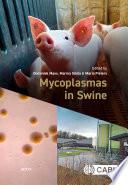Mycoplasmas in Swine

Prasata mohou být infikována mnoha různými mykoplazmy. Některé z nich jsou důležitými patogeny, které způsobují významné zdravotní problémy a velké ztráty v odvětví chovu prasat po celém světě. Jiné mykoplazmy nejsou patogenní pro prasata a mohou být považovány za komenzály. Tato publikace poskytuje aktuální vědecké, klinické a praktické informace o nejdůležitějších patogenních mykoplazmatech u prasat. Největší důraz byl kladen na Mycoplasma hyopneumoniae jako ekonomicky nejdůležitější, ale jsou diskutovány i další patogenní druhy jako Mycoplasma hyorhinis, Mycoplasma hyosynoviae a Mycoplasma suis.
Publikaci sestavili mezinárodně uznávaní vědci a lékaři z celého světa. Spojují v ní hluboké odborné znalosti a zkušenosti s mykoplazmy prasat a poskytují vědecky založenou, akademicky přísnou a praktickou sbírku. Cílem je sloužit vědecké a veterinární komunitě a odvětví prasat po celém světě.
Autor: Dominiek Maes is full professor and head of the Unit of Porcine Health Management at the Faculty of Veterinary Medicine at Ghent University Belgium. He is a specialist of the European College of Porcine Health Management. His main research area is on respiratory disease in pigs, with emphasis on Mycoplasma hyopneumoniae. He is a member of the International Organization of Mycoplasmology (IOM) and has been the chair of the porcine section of the International Research Programme on Comparative Mycoplasmology (IRPCM) within the IOM. Marina Sibila is a researcher at Centre de Recerca en Sanitat Animal (CReSA) since 2004. This research center, located in Bellaterra (Barcelona), is the animal health program of Institut de Recerca i Tecnologia Agroalimentàries (IRTA). Her research line is focused on swine respiratory diseases, mainly Mycoplasma hyopneumoniae among other pathogens. During these years, she has worked to expand the knowledge on Mycoplasma hyopneumoniae epidemiology, animal model development, diagnostic tools assessment and evaluation of disease control strategies. Maria Pieters is a faculty member at the College of Veterinary Medicine of the University of Minnesota (UMN) in the United States. Veterinarian by training, she has dedicated more than 15 years of research efforts to aid defining and developing areas of diagnostics, epidemiology, and control of swine Mycoplasma species, with special interest on d isease elimination. She is the principal investigator of the UMN Mycoplasma Research Laboratory and an active member of the International Organization for Mycoplasmology.
| Nakladatel | CABI International |
|---|---|
| ISBN | 9781789249941 |
| Vydání | 2021 |
| Vazba | pevná |
| Počet stran | 344 |
Swine can be infected with many different mycoplasmas. Some are important pathogens, causing significant health and welfare issues in pigs and major losses to the swine industry worldwide. Other mycoplasmas are not pathogenic for swine and can be considered commensals. This book provides up-to-date scientific, clinical and practical information of the most important pathogenic mycoplasmas in swine. Most emphasis has been placed on Mycoplasma hyopneumoniae as the most economically important, but other pathogenic species like Mycoplasma hyorhinis, Mycoplasma hyosynoviae and Mycoplasma suis are also discussed.
Written by internationally renowned scientists and clinicians from all over the world, this book draws together in depth knowledge, expertise and experience in swine mycoplasmas to provide an evidence-based, academically rigorous and practical collection. It aims to serve the scientific and veterinary community and the swine industry worldwide.
Dominiek Maes is full professor and head of the Unit of Porcine Health Management at the Faculty of Veterinary Medicine at Ghent University Belgium. He is a specialist of the European College of Porcine Health Management. His main research area is on respiratory disease in pigs, with emphasis on Mycoplasma hyopneumoniae. He is a member of the International Organization of Mycoplasmology (IOM) and has been the chair of the porcine section of the International Research Programme on Comparative Mycoplasmology (IRPCM) within the IOM.
Marina Sibila is a researcher at Centre de Recerca en Sanitat Animal (CReSA) since 2004. This research center, located in Bellaterra (Barcelona), is the animal health program of Institut de Recerca i Tecnologia Agroalimentàries (IRTA). Her research line is focused on swine respiratory diseases, mainly Mycoplasma hyopneumoniae among other pathogens. During these years, she has worked to expand the knowledge on Mycoplasma hyopneumoniae epidemiology, animal model development, diagnostic tools assessment and evaluation of disease control strategies.
Maria Pieters is a faculty member at the College of Veterinary Medicine of the University of Minnesota (UMN) in the United States. Veterinarian by training, she has dedicated more than 15 years of research efforts to aid defining and developing areas of diagnostics, epidemiology, and control of swine Mycoplasma species, with special interest on d isease elimination. She is the principal investigator of the UMN Mycoplasma Research Laboratory and an active member of the International Organization for Mycoplasmology.
Table of contents
1: Overview of the general characteristics and classification of porcine Mycoplasma species
2: Diversity of Mycoplasma hyopneumoniae strains
3: Mycoplasma hyopneumoniae pathogenicity: the known and the unknown
4: Epidemiology of Mycoplasma hyopneumoniae infections
5: Mycoplasma hyopneumoniae clinical signs and gross lung lesions, including monitoring
6: Immune responses against porcine Mycoplasma infections
7: Interactions of Mycoplasma hyopneumoniae with other pathogens and economic impact
8: Diagnosis of Mycoplasma hyopneumoniae infection and associated diseases
9: General control measures against Mycoplasma hyopneumoniae infections
10: Antimicrobial treatment of Mycoplasma hyopneumoniae infections
11: Vaccines and vaccination against Mycoplasma hyopneumoniae
12: Eradication of Mycoplasma hyopneumoniae from pig herds
13: Mycoplasma hyorhinis and Mycoplasma hyosynoviae in pig herds
14: Mycoplasma suis infections in pigs